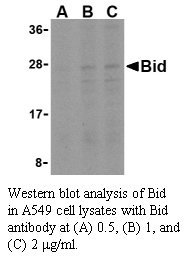Anti-Human BID (Intermediate Domain)
Data
- -
- -
Antibody DetailsProduct DetailsReactive Species Human Host Species Rabbit Immunogen PN:B487 Product Concentration 0.5 mg/ml Formulation This polyclonal antibody is formulated in phosphate buffered saline (PBS) pH 7.4 containing 0.02% sodium azide as a preservative. Storage and Handling This polyclonal antibody is stable for at least one week when stored at 2-8°C. For long term storage, aliquot in working volumes without diluting and store at –20°C in a manual defrost freezer. Avoid Repeated Freeze Thaw Cycles. Shipping Next Day Ambient RRIDAB_2828212 Each investigator should determine their own optimal working dilution for specific applications. See directions on lot specific datasheets, as information may periodically change. DescriptionDescriptionSpecificity Rabbit Anti-Human BID recognizes an epitope in the intermediate domain of human and mouse Bid. This polyclonal antibody was purified using affinity chromatography. Background Bid is a member of the Bcl-2 family of proteins that regulates outer mitochondrial membrane permeability. Bid is a pro-apoptotic member that causes cytochrome c to be released from the mitochondria intermembrane space into the cytosol. In healthy cells Bid is cytosolic. In response to Fas ligand or TNF Bid is cleaved by caspase-8 and it then relocates to the mitochondria outer membrane. Cleavage of Bid by caspase-8 generates a new N-terminal that contains a terminal glycine. It appears that the glycine is myristoylated and myristoylation serves to target Bid to the mitochondria. Bid may then interact with another pro-apoptotic Bcl-2 family member Bak. Interaction of Bid with Bak causes altered mitochondrial membrane permeability. A 9 - 13 amino acid stretch called the BH3 region (Bcl-2 homology region) appears to mediate the Bid interaction with other Bcl-2 family members. Bid is neutralized by binding to the anti-apoptotic member Bcl-x. PubMed References & Citations1. Lockshin, RA. et al. (2000) Cell Death Differ. 7:2-7. 2. Cory, S. et al. (2003) Oncogene 22:8590-607. 3. Heiser, D. et al. (2004) Exp. Geron. 39:1125-35. 4. Wang, K. et al. (1996) Genes Dev. 10:2859-69. Technical ProtocolsCertificate of Analysis |
Related Products
- -
- -
Prod No. | Description |
|---|---|
B456 | |
B487 | |
B486 | |
B645 | |
B594 | |
B617 |



